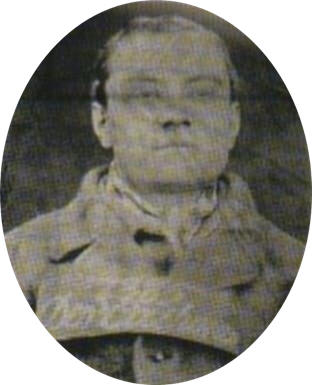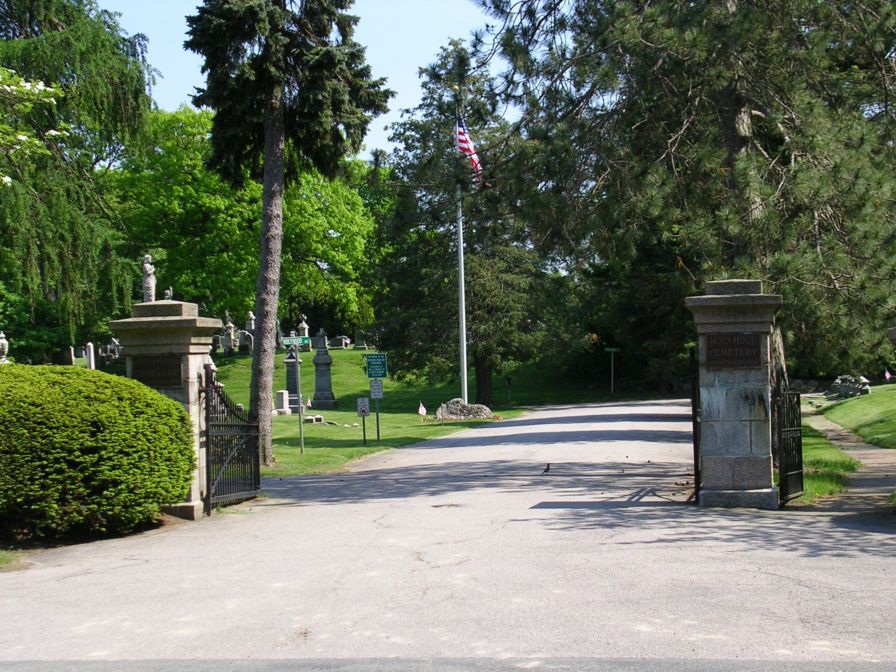Denis B. Cashman (1842–1897)
Fenian, Felon of our land, Poet, Writer and Publisher
 Life in Ireland
Life in Ireland
Denis Bambrick Cashman was born to John Cashman and Mary Bambrick in the Burgery, Abbeyside, Dungarvan in Co. Waterford in 1842. As best as can be determined he had two older brothers born in the mid to late 1830s. Little else is known of his family’s background or livelihood.
As to Cashman’s education it is likely that he attended a local primary school within the Irish National School System, established in 1831 following the Roman Catholic Relief Act of 1829 commonly known as Catholic Emancipation. Despite his literary success later in life there is no record of Cashman receiving any secondary or tertiary education, nonetheless, it’s evident that he was highly intelligent and resolute like many his revolutionary contemporaries.
When Cashman left Dungarvan to live in Waterford city is unknown, What is known with some degree of certainty is that he was living at 2 Barkers Street in Waterford city in 1862 and was employed by Dobbyn and Tandy as a law clerk from 1862 until 1865. What is also known is that he got married in 1862 to his wife Cathrine Veale, with whom he had five children, three of whom were born in Ireland and two in the United States.
Shortly after the Irish Republican Brotherhood (IRB) was founded in 1858, Cashman became a member. The IRB was a secret oath-bound organization dedicated to ending British rule in Ireland and establishing an independent democratic republic. It’s unclear if he, Cashman, joined while living in Dungarvan or after relocating to Waterford city. Irrespective, he quickly rose through ranks to become head of the Waterford IRB Circle responsible for recruiting and swearing in new members. In 1865 he moved to Dublin in a move believed to be related to his IRB activities involving preparations for a nationwide uprising.
The uprising, originally scheduled for 1865, was foiled by the British after they came in possession of documents lost by an emissary from the Fenian Brotherhood in America that contained details for the planned uprising. They were also in possession of collaborating information provided by the informer, Pierce Nagle, who worked in the IRB’s newspaper office. Acting on that information, the British raided the newspaper’s office and arrested several of the IRB leaders including John O’Leary, Thomas Clarke Luby, Jeremiah O’Donovan Rossa and Brian Dillon. Shortly afterwards, Stephens and several other leaders were arrested.
In August of 1866, habeas corpus was suspended in Ireland resulting in the arrest of hundreds of IRB activists.
On January 12, 1867, Cashman was arrested at his home on Preston Street in Dublin where he was living with his wife Cathrine and two sons, William and Arthur. On that very same day Cathrine gave birth to their third son Denis. Subsequent to his arrest, he was charged with involvement in the manufacturing and distribution of rifle cartridges for the IRB on the word of an informer. On February 19, 1867, he was tried and found guilty of treason-felony and sentenced to seven years penal servitude. When asked at his trial if he would plead to a lesser offence because of his youth he replied “No! If I had my life to live over I would do it all again, I am willing to die for Ireland.”
The last days of his life in Ireland were spent in Kilmainham Jail in Dublin before his trial and in the Richmond- Bridewell jail during and after his trial. He was transferred to the Millbank jail in London before being transported to Freemantle Western Australia on Sept 30 1867 aboard the convict ship ‘Hougoumont’.
Life aboard the Hougoumont and in Freemantle
The Hougoumont, the last convict ship to transport convicts to the penal colonies in Western Australia left Sheerness in Kent on Sept 30 1867. Enroute, it boarded more convicts in P0rtland, Dorset. Included amongst the 280 convicts on board were 62 IRB prisoners of which 17 were military prisoners i.e., IRB prisoners who had served in the British army, consequently, condemned to languish in prison for life. (1)
During the voyage, the IRB political prisoners were separated from common criminal prisoners. Despite their rebellious behavior against the English monarch, they were treated with respect and afforded a modicum of freedom by the captain and crew. As a result, they were able to communicate freely and engage in various social related activities. Unlike many of the other prisoners, they were all literate with a good command of the English language. Including amongst them was a scattering of scholars, writers and poets.
Free interaction within the ranks of the IRB prisoners led to the emergence of leaders. Under their guidance, meetings were held to organize activities including concerts and the production of a handwritten newspaper. The title given the newspaper was “The Wild Goose: -Collection of Ocean Waifs” John Flood was the editor, John B. O’Reilly the sub-editor and John Edward Kelly (2) the manager. The design including the artwork and calligraphy for the newspaper’s masthead was the work of Cashman. The newspaper featured various content including poetry, stories, articles, fictional weather reports, and critiques of the correspondents."
During the three-month voyage, seven issues of the newspaper were produced, with multiple copies made as souvenirs. Various prisoners, including Cashman, contributed content, while others with steady hands put ink to paper."
In the last edition of ‘The Wild Goose’ Cashman wrote 'The end of your passage quickly approaches, and already your hearts are beginning to quicken with anticipation at what may be your future in the new land you are fast nearing. I know not what may be in store for you. I cannot pierce the inexorable veil of the future, drawn alike for me and for you; but bidding you a long farewell most likely, however we may wish it, never to meet again, I say to you - Courage, and trust in Providence.
A journey of 14,000 nautical miles that started out in despair for the IRB prisoners including Cashman, gave way to acceptance by the time the Hougoumont, the last convict ship to arrive in Australia, docked in Fremantle on January 9, 1868.
On arrival at the Freemantle prison, Cashman, Kelly, Thomas McCarthy Fennell and other IRB prisoners was assigned to work with convicted criminal on road construction. They were harshly treated by starvation and other cruel means. John Boyle O’Reilly and another group of IRB prisoners was transferred to Bunbury, a hundred or so mile down the coast from Freemantle, to also work on road construction.
Cashman was anything but a model prisoner during his time in Freemantle. He was punished on a number of occasions for insolence and clandestine correspondence for which he was put on a diet of bread and water for up to a week.
Freedom and Life in America
In the meantime, back home in Ireland, an amnesty committee was set up in November 1868 to campaign for the release of Irish political prisoners. The committee included John Nolan, (amnesty John) Isaac Butt and other prominent individuals. Due to the pressure exerted on the British government by the monster petitions and demonstrations organized by amnesty John, the British government relented and started to release some prisoners in 1869. The United States government also petitioned the British for the release of the American Fenians. By 1871 all of the IRB prisoners were released including the American Fenians. The so called military prisoners were held back to rot in Fremantle.
Cashman was amongst the 35 IRB prisoners who received free pardons in May of 1869. After being released, Cashman and his freed compatriots made their way to Albany with the help of Irish settlers they encountered along the way. In September of 1869, Cashman and 25 of his other freed compatriots boarded the ship Rangatira in Albany for Sydney via Melbourne. The following October Cashman, and 14 of his compatriots boarded the ship Baringa in Sydney on their way to a new life in the United States arriving in San Francisco on January 26, 1870. From San Francisco, Cashman took the Central Pacific Railroad to Council Bluffs in Iowa and from there utilized the eastern US railroad system to get to Boston where he was reunited with his wife Catherine and his son William. The reunion was bittersweet as his other two sons, Arthur and Denis has died from measles whilst he was in prison.
Cashman was also reunited with his friend and fellow prisoner, John Boyle O’Reilly, who got him a job at the 'Boston Pilot,' a Catholic newspaper owned by Cavan-born Patrick Donahoe. Cashman worked in the book and publishing department, later becoming its business manager. He also worked as a salesman for Donahoe’s Magazine and after that became the Superintendent of the Wastewater Department in Boston."
When John Devoy journeyed to Boston in 1875 to consult with John Boyle O’Reilly during the initial stages of planning for the Catalpa rescue mission, Cashman was present at that meeting to brief Devoy on the layout and working of the prison. When the Catalpa landed in New York on August 19, 1876, Cashman was there as a reporter to cover the celebratory event for the Boston Pilot.
Although Cashman never returned to Ireland, he kept abreast of what was happening there regarding its ongoing struggle for freedom. In his new hometown of Boston, he was a respected presence amongst his fellow countrymen and women at sporting, social and political events. He was particularly active during the Land League years serving on various committees set up to assist Land League advocates visiting the United States including Michael Davitt and Charles Stewart Parnell. He considered Davitt, a fellow IRB member, to be an effective and fearless advocate for land reform and human rights for the rural dwellers of Ireland. Such was his regard for Davitt, that he wrote a biography of Davitt titled ‘The Life of Michael Davitt”, that incorporated a history of the rise and development of the Irish National Land League.
Denis Bambrick Cashman died suddenly on January 8, 1897 at his home, Worcester St., Boston. He was survived by his wife, Cathrine, his son William and daughters, Mary and Kathleen. He was buried in Holyhood cemetery in Brookline with two of his children, Clement and Louis who preceded him in death. Their grave close to Cashman’s closest friend, John Boyle O’Reilly.
--------------------------------------------------------------------------------------------------------------------------------------
Notes
(1) John Boyle O’Reilly, who at one point during the voyage wanted to commandeer the Hougoumont and sail to America, was convinced otherwise by Cashman and other prisoners. However, he had made good his escape from the Bunbury convict camp in February of 1869 with the help of Father Patrick McCabe and made his way to America on board the whaling ship Gazelle. Six of the others, military prisoners including Martin Hogan, Thomas Hassett, James Wilson, Michael Harrington, Thomas Daragh and Robert Cranston were rescued by the Catalpa rescue expedition in April 1876.
(2) On March 5, 1867, John Edward Kelly together with Peter O'Neill Crowley and Captain John McClure, fought a pitched battle with a 300 strong contingent of British soldiers and police in Kilclooney Wood close to Mitchelstown in Cork. Peter O'Neill Crowley, a native of East Cork, was fatally wounded and died shortly afterwards in Mitchelstown. Kelly and McClure were captured, charged with high treason and sentenced to be hanged. The sentence was later commuted to penal servitude for life. Kelly was the only known American Fenian aboard the Hougoumont.
Contributed by Tomás Ó Coısdealbha
cemetery
Name: Holyhood cemetery
ADDRESS: 584 Heath Street, Brookline, MA 02467


